 W
WActiniidae is the largest family of sea anemones, to which most common, temperate, shore species belong. Most members of this family do not participate in symbioses with fishes. Three exceptions are the bubble-tip anemone, snakelocks anemone and Urticina piscivora.
 W
WActinia is a genus of sea anemones in the family Actiniidae. Actinia display a rare form of heteromorphosis in which a cut inflicted on a specimen can develop into a second mouth.
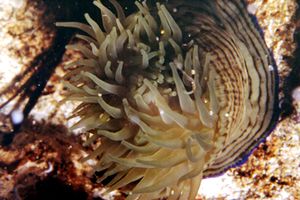 W
WActinia cari is a species of sea anemone in the family Actiniidae. It is native to the Mediterranean Sea where it is an uncommon species.
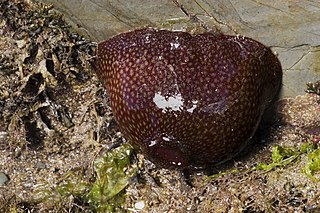 W
WActinia fragacea, commonly known as the strawberry anemone, is a species of sea anemone of the order Actiniaria, that occurs from Norway to Africa, including adjacent islands and the Mediterranean. It is generally found on rocks of the lower shoreline and depths up to 8–10 metres (26–33 ft).
 W
WActinia mediterranea is a common sea anemone found on rocky shores all along its range in the Mediterranean Sea, Portuguese shores and the coast of north western Africa. Because of its strong resemblance with Actinia equina, they are often confused and share certain common names as Beadlet anemone.
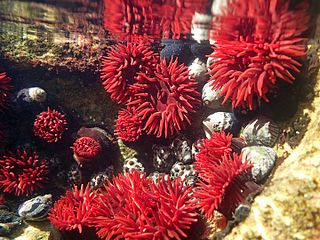 W
WActinia tenebrosa, commonly named Waratah anemone, is the most common species of sea anemone found in the waters of eastern Australia, and New Zealand. It is found relatively high on the seashore, in rock pools, and various cracks and shaded surfaces such as under rock overhangs in the intertidal zone.
 W
WThe aggregating anemone, or clonal anemone, is the most abundant species of sea anemone found on rocky, tide swept shores along the Pacific coast of North America. This cnidarian hosts endosymbiotic algae called zooxanthellae that contribute substantially to primary productivity in the intertidal zone. The aggregating anemone has become a model organism for the study of temperate cnidarian-algal symbioses.
 W
WAnemonia is a genus of sea anemones belonging to the family Actiniidae.
 W
WAnemonia sulcata, or Mediterranean snakelocks sea anemone, is a species of sea anemone in the family Actiniidae from the Mediterranean Sea. Whether A. sulcata should be recognized as a synonym of A. viridis remains a matter of dispute.
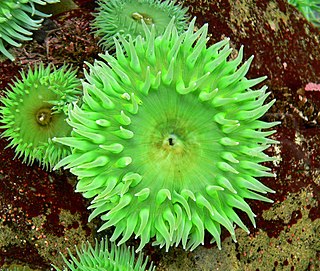 W
WAnthopleura is a genus of sea anemones, of the family Actiniidae.
 W
WAnthopleura artemisia is a species of sea anemone. It is known by a number of common names, including burrowing anemone and moonglow anemone. It was first described to science in 1846 in a volume by James Dwight Dana, reporting on the animals found on the United States Exploring Expedition. Dana attributes the description to Charles Pickering, who was a naturalist on the expedition.
 W
WAnthopleura rosea, commonly known as the rose anemone or rock pool anemone, is a small pink anemone endemic to New Zealand.
 W
WAnthopleura xanthogrammica, or the giant green anemone, is a species of intertidal sea anemone of the family Actiniidae.
 W
WAnthostella is a genus of sea anemones in the family Actiniidae. It has two described species.
 W
WAulactinia is a genus of sea anemones in the family Actiniidae.
 W
WAulactinia veratra, the green snakelock anemone, is a species of sea anemone in the family Actiniidae. It is native to the southeastern Indian Ocean and the southwestern Pacific Ocean.
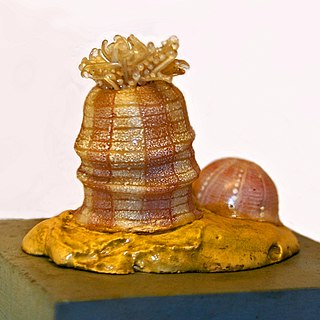 W
WAulactinia verrucosa, the gem anemone, is a species of sea anemone in the family Actiniidae. It is found on rocky coasts in the northeastern Atlantic Ocean, North Sea and Mediterranean Sea.
 W
WThe beadlet anemone is a common sea anemone found on rocky shores around all coasts of the British Isles. Its range extends to the rest of Western Europe and the Mediterranean Sea, and along the Atlantic coast of Africa as far south as South Africa.
 W
WBolocera tuediae, commonly known as the deeplet sea anemone, is a sea anemone found in the sublittoral zone of the North Sea. It was first discovered near Bewick, England by Johnston in 1832. It is distinguished by its large, hexamerous size and shedding of tentacles. The nematocysts of the anemone can have dangerous effects, including the rupturing of human blood cells. The deeplet sea anemone was observed to have a symbiotic relationship with shrimp, as they cluster around its base in both temperate and Northwest Atlantic waters.
 W
WBubble-tip anemone is a species of sea anemone in the family Actiniidae. Like several anemone species, E. quadricolor can support several anemonefish species, and displays two growth types based on where they live in the water column, one of which gives it the common name, due to the bulbous tips on its tentacles.
 W
WBunodactis is a genus of sea anemones in the family Actiniidae.
 W
WBunodosoma is a genus of sea anemones in the family Actiniidae.
 W
WBunodosoma californicum is a species of sea anemone. Is was first described to science by Oskar Carlgren in 1951. The type specimen that Carlgren used to describe the species was collected by Ed Ricketts in Puerto Escondido during his trip to the Gulf of California with John Steinbeck recounted in The Log From the Sea of Cortez.
 W
WCondylactis aurantiaca, commonly known as the golden anemone, is a species of sea anemone in the family Actiniidae. This species always remains largely buried in sand or sediment, attached to the substrate, with only the oral disc and tentacles visible.
 W
WCondylactis gigantea is a tropical species of ball anemone that is found in shallow reefs and other shallow inshore areas in the Caribbean Sea – more specifically the West Indies – and the western Atlantic Ocean including southern Florida through the Florida Keys. It is also commonly known as: giant Caribbean sea anemone, giant golden anemone, condylactis anemone, Haitian anemone, pink-tipped anemone, purple-tipped anemone, and Florida condy. This species can easily be seen growing in lagoons or in inner reefs as either individuals or loose groups, but never as colonies. They are often used as a model organism along with others in their genus for facultative symbiosis with monocellular algae.
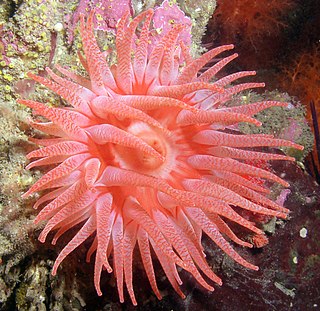 W
WCribrinopsis fernaldi, also known as the crimson anemone, snakelock anemone, chevron-tentacle anemone and Fernald brooding anemone, is a sea anemone native to the Pacific Ocean off northwestern North America.
 W
WThe dahlia anemone is a sea anemone found in the north Atlantic Ocean, the North Sea and the Baltic Sea. Its colour is variable, from deep red to brown or purplish, with green spots and darker tentacles. Dahlia anemones live attached to rock on the seabed from the lower tidal limit down to a depth of 100 m and also attached to other organisms. Their diet comprises small fish and crustaceans, which they immobilize by firing groups of stinging cells (cnidae) into them. Dahlia anemones are closely related to mottled anemones, and both species are usually referred to as northern red anemones.
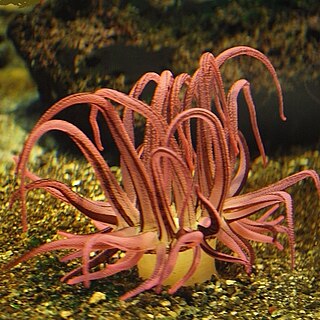 W
WDofleinia armata, commonly known as the striped anemone or armed anemone, is a species of sea anemone in the family Actiniidae.
 W
WEpiactis is a genus of sea anemones in the family Actiniidae. There are about nineteen recognised species and the type species is Epiactis prolifera.
 W
WEpiactis prolifera, the brooding, proliferating or small green anemone, is a species of marine invertebrate in the family Actiniidae. It is found in the north-eastern Pacific. It has a feature rare among animals in that all individuals start life as females but develop testes later in their lives to become hermaphrodites.
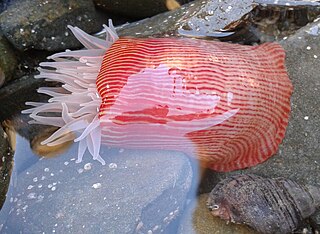 W
WEpiactis thompsoni, the red-striped anemone, is a species of marine invertebrate in the family Actiniidae, found in New Zealand and South Australia. They are commonly found in the rocky intertidal zone.
 W
WBunodosoma capensis, commonly known as the knobbly anemone, is a species of sea anemone in the family Actiniidae.
 W
WAnthopleura michaelseni, commonly known as the long-tentacled anemone or crevice anemone, is a species of sea anemone in the family Actiniidae. It is native to very shallow water round the coasts of southern Africa between Lüderitz and Durban.
 W
WMacrodactyla doreensis, common names long tentacle anemone and corkscrew tentacle sea anemone, is a species of sea anemone in the family Actiniidae.
 W
WUrticina crassicornis, commonly known as the mottled anemone, the painted anemone or the Christmas anemone, is a large and common intertidal and subtidal sea anemone. Its habitat includes a large portion of the coastal areas of the northern hemisphere, mainly polar regions, and it lives a solitary life for up to 80 years. Mottled anemones are similar to Dahlia anemones and both are commonly referred to as northern red anemones.
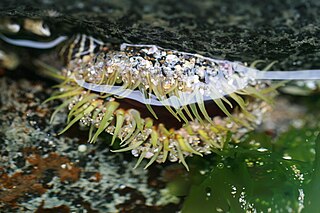 W
WOulactis is a genus of sea anemones in the family Actiniidae, found in the intertidal zone. It contains the following species:Oulactis cincta (Stuckey, 1909) Oulactis coliumensis (Riemann-Zürneck & Gallardo, 1990) Oulactis concinnata (Drayton in Dana, 1846) Oulactis magna (Stuckey, 1909) Oulactis mcmurrichi (Lager, 1911) Oulactis muscosa (Drayton in Dana, 1846) Oulactis orientalis (Averincev, 1967)
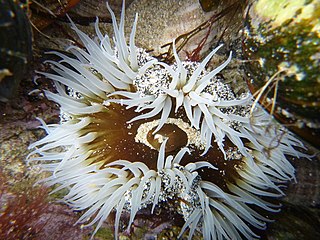 W
WOulactis magna, commonly known as the giant shore anemone or camouflaged anemone, and by its Māori name kōtore tino nui, is a common sea anemone found in New Zealand.
 W
WOulactis muscosa, also known as the sand anemone and speckled anemone, is a species of sea anemone in the family Actiniidae.
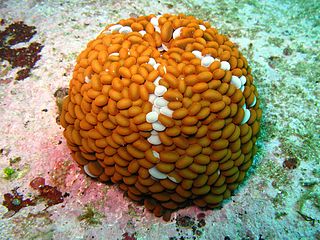 W
WPhlyctenactis tuberculosa, common name the wandering sea anemone or swimming anemone, is a species of sea anemone in the family Actiniidae. It is native to shallow seas around Australia and New Zealand. It was first described by the French zoologist Jean René Constant Quoy and the French naturalist Joseph Paul Gaimard. They were naval surgeons serving in the French Navy and made extensive collections of organisms they came across in their travels.
 W
WPhlyctenanthus australis, commonly known as red anemone and southern anemone, is a species of sea anemone in the family Actiniidae. It grows to a maximum size of 10 cm in diameter. The column is red-brown in colour with blue vesicles covering it. The tentacles are reddish-brown and short, and number up to around 100. This species is found in south Australia, New South Wales, down to Tasmania. This species lives on exposed reefs at depths of between 1 and 35 metres.
 W
WPseudactinia is a genus of sea anemones in the family Actiniidae.
 W
WPseudactinia flagellifera, the false plum anemone, is a species of sea anemone in the family Actiniidae. It is also a member of the kingdom, Animalia.
 W
WThe sandy anemone is a species of sea anemone in the family Actiniidae. It is native to very shallow water round the coasts of southern Africa between Luderitz and Durban.
 W
WThe snakelocks anemone is a sea anemone found in the eastern Atlantic Ocean and the Mediterranean Sea. The latter population is however sometimes considered a separate species, the Mediterranean snakelocks anemone.
 W
WKorsaranthus natalensis, commonly known as the spinnaker anemone or the candy-striped anemone, is a species of sea anemone in the family Actiniidae. It is the only member of its genus.
 W
WThe sunburst anemone is a species of sea anemone in the family Actiniidae. The sunburst anemone was formerly considered the solitary form of the common aggregating anemone, but was identified as a separate species in 2000.
 W
WUrticina is a genus of relatively large and often colorful sea anemones in the family Actiniidae from the North Pacific, North Atlantic and Arctic Oceans.
 W
WUrticina columbiana, common names crusty red anemone, Columbia sand anemone, sand anemone, and the sand-rose anemone, is a species of sea anemone in the family Actiniidae.
 W
WUrticina eques is a species of sea anemone in the family Actiniidae. It is commonly known as the white-spotted rose anemone or strawberry anemone.
 W
WUrticina piscivora, common names fish-eating anemone and fish-eating urticina, is a northeast Pacific species of sea anemone in the family Actiniidae.
 W
WAnthostella stephensoni, the violet-spotted anemone, is a species of sea anemone in the family Actiniidae.